Cracked cement stairs reach up in front of me through the woods. A thumb-sized ball of sticky white rice is placed every few feet along both edges of the stairway. Two Lao women lead me by twenty feet or so, chatting quietly and dressed in bulky jackets against the cool morning fog.
They carry their sticky rice in small baskets that hang down by their sides. Each leaves their periodic little offerings on their respective side of the stairs. One runs out of rice before we reach the small pagoda at the top of Mount Phu Si, a hill in the middle of Luang Prabang.
The women take a couple photos of the pagoda at the top before kicking off their shoes and ducking inside. The sunrise arrives soon but keeps quiet about it all, mostly obscured behind clouds from last night’s downpour along the Mekong River.
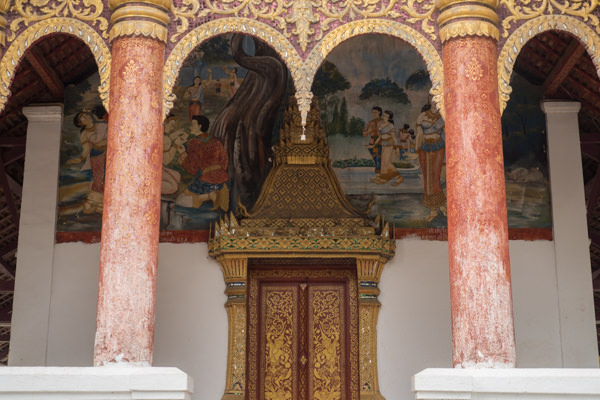
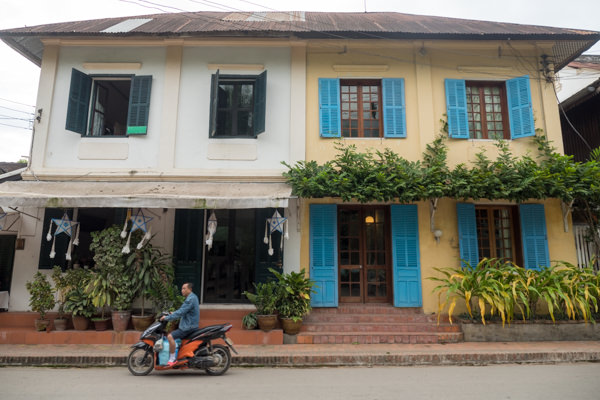
It’s the only time during the day in Luang Prabang that I’m the only foreigner in sight.
Luang Prabang deserves the hordes of tourists, between the colonial architecture, expansive temples, sunsets on the banks of the Mekong, and diverse food. Next to cities like Chiang Mai, the count of tourists who visit Luang Prabang is relatively small.
But this isn’t a big place. A person can walk a loop through the whole town in an hour or so.
Luang Prabang sits on a peninsula where the Khan River flows into the Mekong, the powerful artery of Southeast Asia that feeds as many as 70 million people. This little peninsula was the capital of Laos until the Phatet Lao government took power in 1975. Today, thirty-three of its temples are inside a UNESCO World Heritage Site, with many more in the area.
For travelers nervous about feeling bogged down by the crowds, there are a few standout places to visit, eat, and explore that are uniquely Luang Prabang, regardless of how many tourists you share the experience with.
Things to do in Luang Prabang
UXO (Unexploded Ordnance) Lao Visitor Centre
The UXO Lao Visitor Centre is a small museum on the edge of the touristy section of Luang Prabang, dedicated to educating people about the impact of the US “Secret War” in Laos.
From 1964 to 1973, the US military ran over a half-million bombing missions that dropped over 2 million tons of explosives on Laos. This averages out to one planeload of bombs every eight minutes for nine years. As many as one third of the bombs failed to explode, covering the country in munitions. These bombs used to kill around 300 people per year, but that number has now dropped to about 50. Less than 1 percent of the unexploded bombs have been cleared. The U.S. spent, in today’s dollars, $13.3 million per day on bombing campaigns during the war, but until 2016 was contributing an average of $4.9 million each year to efforts to clean up the UXO in Laos. In 2016, Obama pledged an additional $90 million to help clear the bombs.
Luang Prabang’s UXO Vistor Centre is one of the few pieces of war history visible in the town. The museum is full of information on the effects of the war and the process to clean up the aftermath. The bombs themselves are on display, with exhibits detailing how the UXO teams work to find and safely clear them.
Entrance is free.
Wat Xieng Thong
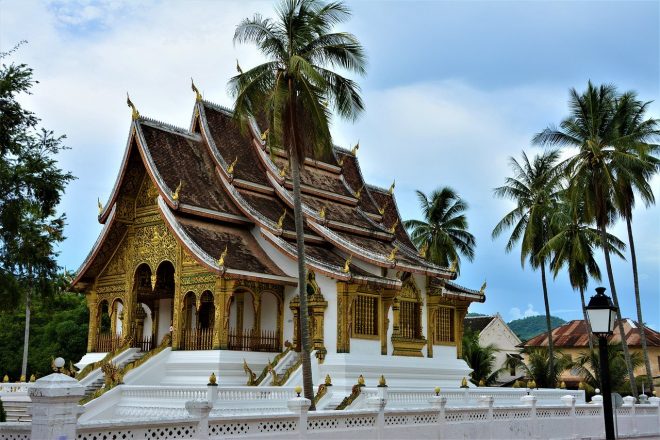
You don’t really need to plan your temple visits in Luang Prabang – just wander into any of them as you pass, as long as there isn’t an event or a service happening. Nearly all are classic examples of Buddhist craftsmanship, with legends and icons depicted across walls and ceilings.
The most famous of them might be Wat Xieng Thong, near the tip of the peninsula. It costs 20,000 kip to enter, but this is one that helped Luang Prabang gain UNESCO World Heritage Status.
Ock Pop Tok Living Craft Centre
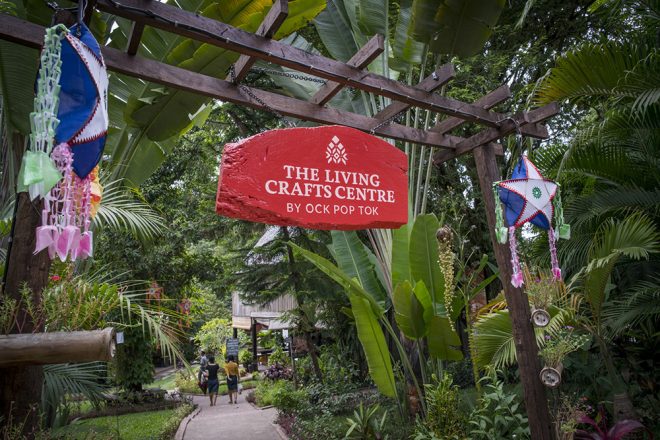
Ock Pop Tok is a textile social enterprise founded by a British woman and a Lao woman, with the goal of building economic opportunities for Lao artisans and preserving traditional Lao culture. They employ 50 full-time weavers and work with a network of over 500 women from many of Laos different ethnic groups. The Ock Pop Tok collective gives the women a secure source of income and also opportunities to gain recognition as master weavers. Some of the women who work with Ock Pop Tok travel to a folk art festival in New Mexico every year to connect with artisans and buyers from across the globe.
They offer free tours of their Living Craft Centre, as well as classes in weaving, natural dyeing and batik, ranging from a half-day to three days. They also have a store on the main street in town and their Silk Road Cafe serves traditional Lao food at both locations. You can also stay in their Mekong Villa, right on the river.
Gravek Storytelling
Gravek is a traditional storytelling project that works to share and preserve the legends and stories of Luang Prabang. Every night at 6:30 PM, a Lao storyteller welcomes a small group into a little black box theater to tell myths of naga serpents, kings, flying monkeys, and the land around the ancient kingdom of Luang Prabang. The stories are interspersed with music by an energetic old master of the Lao “khene” – a complex bamboo flute. There’s no chance of a big crowd here because the theater is tiny.
Entrance costs 50,000 kip. Drinks for sale inside. Gravek also has a project in Siem Reap.
Mount Phu Si
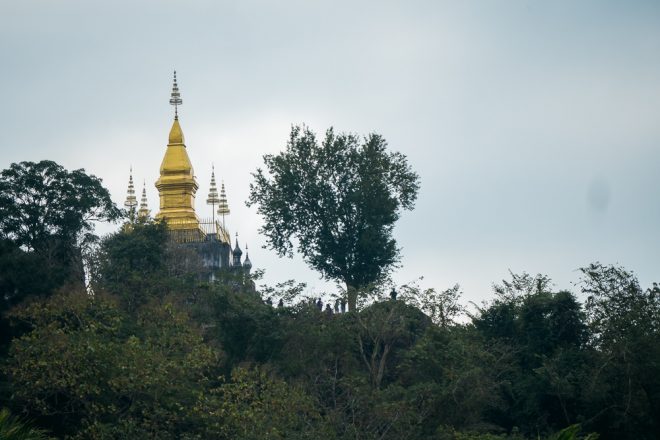
Mount Phu Si is in the center of town and the top offers a view of both rivers and all of Luang Prabang. The top is a small viewing platform and a pagoda with a worship hall. The view at sunset is one of the best in Luangprabng but the top gets packed with tourists and it may not be worth it. Travelers may appreciate the view a bit more and find it easier to tolerate the crowds after a few days in town. If you’re looking for a calming spot to watch the sun drop into the Mekong, just head to the riverbank. If you come at sunrise, you may be joining some Lao Buddhists as they walk up to make offerings and pray at the pagoda.
It takes less than 15 minutes to climb and you can enter from the northwest side on Sisavangvong road in the middle of the night market or from the northeast side, through Wat Siphoutthabath temple. If you take the route up or down through the temple, the path winds through sets of golden Buddha statue sin varying mudras. Also look for a small cave on your left.
Entrance is 20,000 kip from either side.
Kuang Si Waterfall
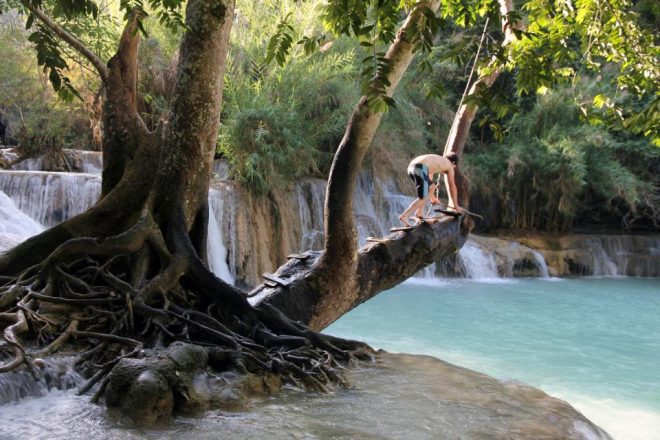
You don’t need this guide to tell you about Kuang Si Waterfall. The tiered, bright blue cascades are 30 km from town and every tour agency and guesthouse will be trying to sell you a trip. Take them up on it – a seat in a van should be around 40,000 kip, round trip, or rent a bicycle or motorbike and get out there on your own. If you do, stop at the social enterprise Laos Buffalo Dairy on the way back for ice cream or things with cheese.
Admission to the waterfall area is 20,000 kip or so.
Also check out the note below about coffee tours with Saffron Coffee.
Where to eat and drink in Luang Prabang
The Morning Market and Night Market
There are plenty of tourists at the Morning Market and Night Market, but both offer a chance to eat simple, classic Lao food and see how the town functions.
If you want a less crowded option, try Nang Tao for cheap and delicious Lao noodle and rice dishes or head to the low-key Papaya Salad Stand With the Birdcage by the Temple (this one).
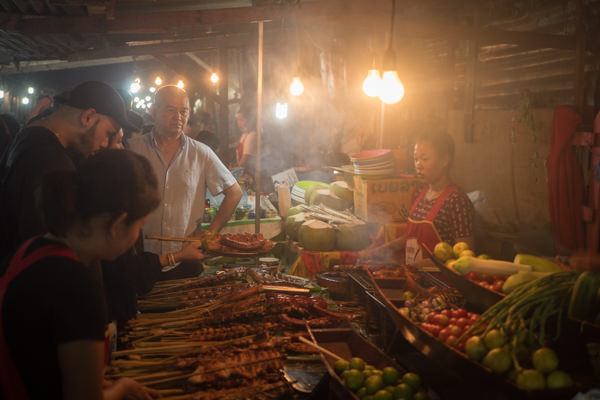
The Morning Market starts before dawn along the little street between the Mekong and Mount Phu Si. Restaurant owners and families come to get their ingredients and plenty of Lao folks stop for breakfast. Grab a table at the khao piak stand near the T intersection in the middle of the market and order khao piak khao (rice porridge), khao piak sen (rice noodle soup) or pho (also rice noodle soup). They all usually come with pork but vegetarians can get them without, or add egg. After breakfast, look to the vendors on either side for snacks – savory fried dough balls, mini coconut cakes, and all manner of sticky rice flour and fruit creations, often covered in coconut or wrapped in banana leaves.
The Night Market has a larger variety of prepared food. The main road in town will be filled with handicraft and souvenir stalls. The best food is at the southwest end, near the intersection of Chaofa Ngum and Kitsalat Road, mostly in the alley next to Indigo Cafe. Look for barbecue, a greasy vegetarian buffet, more pho and khao piak, and soup stalls where you can pick your own ingredients and they’ll make it to order. There’s also a large stand of extravagant baked goods next to the entrance to the alley. This is one of the cheaper places to eat in Luang Prabang, and you’ll see every kind of traveler as well as Lao folks there. The craft rice whiskey stand is also worth noting – it’s in the middle of the souvenirs section of the night market, on the southeast side of the street.
Saffron Coffee
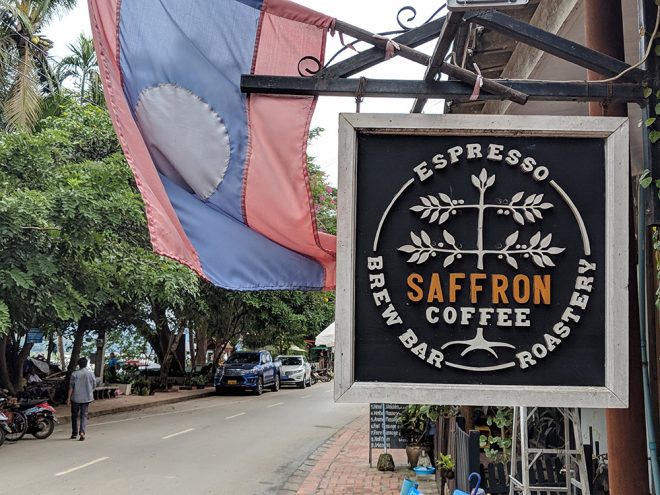
Saffron Coffee is a cafe and coffee roastery right on the Mekong River, selling specialty coffee grown as locally as possible in northern Laos. It’s one of the most innovative social impact businesses in Luang Prabang, working with farmers across northern Laos to produce the best coffee they can.
Lao coffee has traditionally consisted of Robusta coffee plantations in the south of the country, with much of the product sold to Vietnam and passed off as Vietnamese coffee. Saffron partners with 25 Khmu, Hmong, Mien, and Gasak ethnic villages in the north, many of whom have never grown coffee, to plant much more valuable Arabica coffees, improve farming practices and build a direct-trade economy through a cooperative model. Saffron now produces around 10 tonnes of wet-processed coffee per year. This spring, they’ll supply their farmers with 50,000 new coffee seedlings to be planted at 800 meters or more above sea level.
The coffee doesn’t just sound good, it has the flavor to back it up. The cafe does breakfast and has a deck overlooking the river, across the street. They offer tours out the processing facility, including a tasting, some bonus baked goods, and transportation. Contact them to set it up, or just walk in.
Khaiphaen
Khaiphaen is a social enterprise restaurant that trains Lao youth to work in the hospitality and culinary industries. The organization works mostly with at-risk or marginalized young folks, training them to run every aspect of the restaurant. Khaiphaen is part of the TREE alliance, a group of vocational training restaurants that provide social support and secure employment for people who struggle to access jobs and services.
They serve traditional Lao food and cocktails, with happy hour from 3 to 6 PM. The menu is here, with the highlights being the chicken and squash laap salad and the khaipaen itself – crispy dried and lightly-fried river “weeds” with dipping sauces.
Le Banneton French Bakery
Le Banneton French Bakery serves the best baguette sandwiches and some of the best croissants in town. They stuff their sandwiches with goodies sourced from artisan butchers and other producers in Laos as well as abroad – think boar pate with cognac red wine jam and pickles. It’s certifiably french too – they’ve got galletes, croque monsieurs and wine (so do most of the Western food restaurants in Luang Prabang actually).
Popolo
Popolo is a new, colorfully-rustic spot in town tossing up phenomenal wood-fired pizza with locally-sourced water buffalo mozzarella. The couple that runs it is charming and the primary-toned pastel decor is equally inviting. They also serve up pastas, sandwiches, and cheese and meat spreads. It all starts around 40,000 kip – more than noodle soup on the street but easily worth it. The in-house cocktail bar, Sugar, makes it a laid-back, stylish place to hang out for the night, away from the crowds that crawl along the town’s main roads.
L’Etranger Books & Tea
Reading material, natural products and locally-made textiles line the shelves at L’Etranger Books & Tea, a calming stop and one of many bibliophile corners in Luang Prabang (see Novelty Cafe for another). They sell used books, serve big pots of tea and dish up all-day breakfast and milkshakes. L’Etranger also shows free movies upstairs every night at 7 PM. Check their Facebook to see what’s playing. Entrance is free, just order food or drink.
Some links may be affiliate links, meaning I may earn commission from products or services I recommend. For more, see site policies.
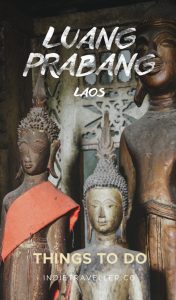
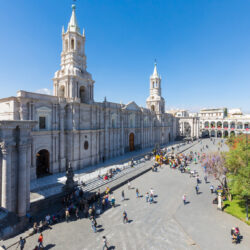
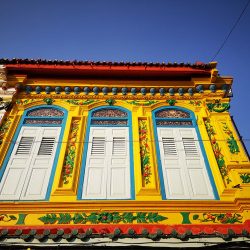




0 comments
Leave a comment
Your email address will not be published. Comments are manually moderated.